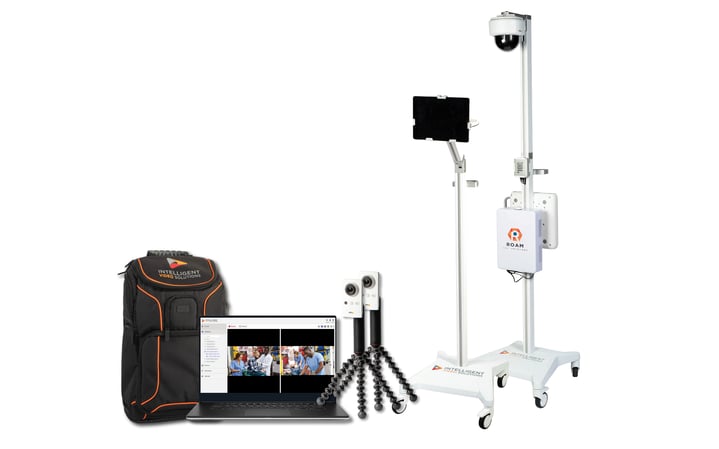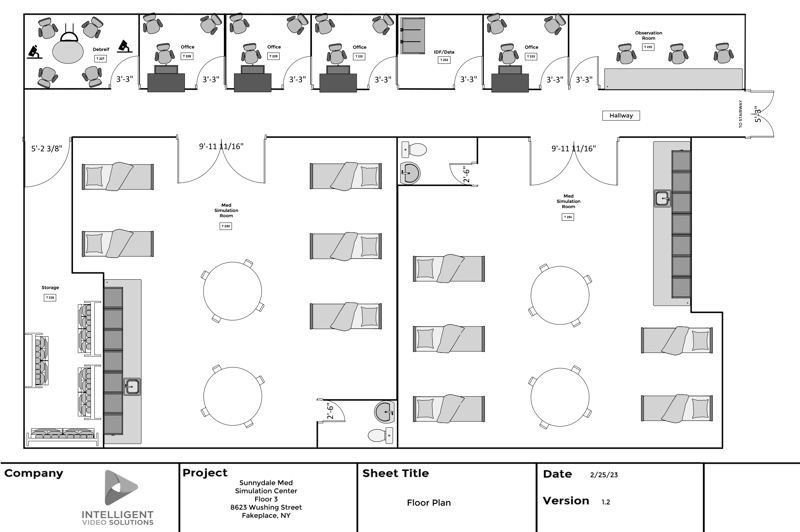If you’re considering an expansion, renovation, or new simulation space, use this guide to brainstorm. It includes topics and tools to use in your early planning stages including key players, funding, and equipment evaluation.
Short on time? Download a copy of the Healthcare Simulation Lab Planning Guide now to save and share!

A healthcare simulation lab or simulation room is a specialized space designed to simulate real-life medical environments and treatments.
Medical professionals use simulation labs to practice, refine, and improve their skills in a safe and controlled environment.
Simulation labs usually contain highly realistic simulation equipment, which can range from patient beds with monitors, IV stands, surgical instruments, manikins equipped with lifelike features, computers used for 3D imaging or data analysis purposes, and other items that could be found in a clinical or hospital setting. Simulation labs also often have designated areas where instructors can observe the activities taking place in the lab and provide feedback as needed.
Audio and video capture equipment is growing in prevalence in simulation labs. The use of recording equipment in the simulation environment enables instructors and students to review recorded lab sessions, facilitating improved learning outcomes and greatly increasing the effectiveness of learning.
Healthcare simulation labs offer an opportunity for students and practitioners alike to hone their skills in a risk-free environment that replicates many of the situations they may encounter in the real world.
The benefits of having access to healthcare simulation labs are wide-ranging.
- Students are better equipped to handle the responsibilities of their chosen profession after receiving practical experience in a safe learning environment.
- Instructors gain valuable insight into how their teaching methods measure up against real world scenarios, allowing them to refine their approach if necessary.
- Doctors can use simulations to test out possible treatments before attempting them on actual patients or develop protocols for certain types of emergencies.
- Nurses gain invaluable confidence by encountering potential complications before they occur in actual patient care settings.
- Communication and teamwork are prioritized with simulation learning, allowing industry professionals, instructors, and students alike to learn from one another and collectively improve outcomes.
Read this unique first-hand perspective on how healthcare simulation improves quality and productivity.
So how can you get started with a plan for a simulation lab?
Healthcare simulation labs provide a unique and powerful learning environment. Proper planning is essential to make the most of this opportunity, providing the best possible learning experience for everyone involved.
Let’s review the details of how to plan a healthcare simulation lab successfully.
1. Determine the Key Players of the Simulation Lab
Planning a simulation space depends on who uses it, how it’s used, and how often. Determine key players and their minimum requirements and wish lists, then plan your simulation space.
Key players are teams, programs, or departments, who use or will use the space. For example, a medical education office, simulation lab team, health science programs, and allied health departments, etc.
Stakeholders, though they are involved in the project, are not key players because they don’t use the space. Stakeholders may include departments such as IT, network administration, grants, or construction.
Ask the following questions to determine your simulation lab key players:
- Who uses, or will use, the space most often?
- How do they, or how will they, use the space?
- What is your priority for the space?
|
EXAMPLE PRIORITIES |
WHY IT MATTERS |
WHAT IT MAY LOOK LIKE |
|
Flexibility |
Configurable space to meet evolving simulation needs. |
Available power, moveable walls or curtains, portable equipment, and versatility of all rooms. |
|
Realism |
Life-like environment to replicate patient care and to best prepare learners for their everyday work. |
High-fidelity manikins, remote observation space, medical equipment, and furniture. |
|
Operating Costs |
How to keep the lights on and make most of the construction costs. |
Sustainable fixed and variable expenses year-over-year. |
|
Logistics |
Who and what goes where and when. |
Standardized Patient prep rooms, traffic patterns, and storage solutions. |
2. Define Your Simulation Lab ‘Must-Haves’
Once you identify key players, invite them to create a list of must-haves, i.e., the bare minimum they require to use the space, and their wish list.
The must-have list should include both space and items acquired post-build to plan where those items are stored and used. Storage is key! Plan for about half of your space to be dedicated storage space.
Consider the key features your simulation room must include to improve learning and practical outcomes for all parties.
Let’s use a simulation lab team as an example. If the team’s priority is realism, their must-have list includes a dedicated control room for the simulation facilitator and simulation technician to observe participants. Otherwise, simulation personnel are physically in the room with participants, which detracts from the simulation’s realism. And the wish list may include a two-way communication system, which is not mandatory for observation, but supports immediate coaching to participants and further improves realism.
As another example, a nursing program’s must-have list includes space and furniture to mirror a clinical environment and a ceiling lift for practicing patient transfers. And their wish list may include a mobile patient lift for additional flexibility.
Below is a template to use to document the must-have and wish lists of key players. Click to download the PDF and share a copy with each key player to use to capture their primary contacts, bare minimum, and wish list items.

3. Draw Your Ideal Simulation Lab Floor Plan Template
After key players provide their bare minimum and wish lists, it’s time to draw your plans. It is often beneficial to create three different simulation lab floor plan templates: the bare minimum, a middle-of-the-road option, and your dream simulation lab space.
First, draw the space or use a floor plan to include the bare minimum requested by your key players. This simulation lab floor plan will use existing space or expand the space slightly. It is helpful to plan out your existing space using exact square footage if possible.
Next, draw the space to include the middle-of-the-road between bare minimum and wish list items. This plan will expand farther than the bare minimum plan and likely include more storage. Consider ways to break up existing rooms into smaller rooms or ways how to create flexible spaces.
Lastly, draw the dream space that includes all the items from the key players’ bare minimum and wish lists.
Now that you have determined key players, their priorities for the space, and have a few different plans, determine what budget or funding is available and how much you need to ask for.
Interested to see the final outcome of a nursing simulation lab plan?
Mount Royal University in Calgary, Canada, provides an exceptional undergraduate educational experience to 12,000 students, including a “living classroom” for research and education with a nursing simulation lab. Read this case study and watch the short video now.
4. Define Your Simulation Lab Budget and Funding
The budget or funding determines which version of your simulation lab plans are possible: bare minimum, middle-of-the- road, or dream space.
To estimate the project budget for each plan, work with the department or consultant who evaluates the cost of design, demolition, construction, renovation, furnishings, and services that will be required. This may be a facilities management department, a construction department, a business services department, consultant, etc. They will help you evaluate project costs.
Once you estimate the project budget, identify if you have an available budget to take on the costs, or if you need to find funding to accomplish your plans. If the available budget will not accomplish your plans, determine how much funding you need to ask for to achieve your dream scenario. For example, if your available budget accomplishes the bare minimum, grant funding may achieve your dream scenario.
Grant programs are available for simulation lab building projects and can help you achieve your project requirements.
Some organizations have a grants department that looks for available grant opportunities, or you may need to do your own research. In addition to project costs, a grant proposal combines data with emotional appeal so make sure you pair facts about your organization and your simulation lab project with who will be served and why it matters. This allows you to tell a story that aligns your goals with the goals of the grant you are applying for. If permitted, include images with your narrative to drive home your need and show the impact of grant funding, such as photos of your current space, floor plans, charts, and tables.

Interested in learning more about grants for simulation spaces?
Read this informative blog now: 5 Tips for Obtaining a Grant for Healthcare Programs.
5. List Required Simulation Lab Equipment and Supplies
Who uses your simulation room, how it’s used and why, determines your simulation lab equipment list. Look back at your list of key players and their priorities/objectives to determine the equipment needs.
For example:
- Is their objective to start an IV? If so, they may require a task trainer arm.
- Is their objective to work on communication skills in a space outfitted to look like an out-patient exam room? If so, perhaps they just need equipment to outfit the room.
- Or is the objective to perform medical diagnoses that requires a high-fidelity manikin?
Just make sure you stick to your budget and allocate financial resources based on the highest priority items. Also, consider wear and tear and the reliability of present and future equipment to get the most out of your simulation space.
Consider Seeking Donations
When you have your list of equipment needs, look for organizations that donate equipment.
Partner with local resources like hospitals, vendors, and private donors. For example, hospitals typically replace patient equipment and simulation equipment every five to ten years, so they may have equipment to sell or donate. Common examples of donated supplies from hospitals is expired or surplus supplies such as IV tubing, IV bags, catheters and dressing supplies. Consider putting a link to request donations of equipment and supplies or funding to purchase equipment on your organization’s website.
Attend Tradeshows for Additional Simulation Lab Supplies
For any equipment that cannot be donated, attend tradeshows to observe demonstrations and test equipment in-person. Tradeshows are a unique opportunity to validate varying equipment makes and models at one time, in one place. For example, if realism is your priority, ask a manikin vendor to demonstrate their high-fidelity manikin simulating human body functions. Or if you’re teaching robotic assisted procedures, ask to test drive virtual reality interactive devices to experience different viewpoints yourself.
If you’re unable to attend tradeshow, reach out to vendors directly to get more information.
Research and Contact Possible Vendors Directly
Invite vendors to your organization to demonstrate their product onsite and invite key players to attend. An on-site demonstration is the most practical option if multiple key players share equipment and need to see a demonstration or trial the equipment themselves prior to purchase.
Social media groups are also beneficial for word-of- mouth recommendations and real-world feedback on equipment and vendors.
And ask for quotes. Just because you like a piece of equipment, does not guarantee it will be within your budget.
Choosing a clinical simulation lab vendor is an important part of choosing equipment. If you are unsure of what to ask vendors, try using these introductory talking points:
|
QUESTION FOR VENDOR |
WHY IT’S WORTH ASKING |
|
What do you do? |
An oldie, but a goodie, this question is the perfect prompt to hear a vendor’s thirty-second elevator pitch about what they offer and why they offer it. If you want to know more, follow with, ‘how is what you offer different than other vendors who provide similar products and services?’. The vendor’s answer helps you compare products. |
|
How do you continue to innovate? |
Years in business establishes durability, but this question establishes credibility as a long-term partner who evolves to meet customer and industry needs. Another way to ask this question is, ‘what new products have you created in the last year?’ |
What other organizations or programs like mine use your product? |
Determine if the vendor’s product is used by peers in your field who share similar goals and priorities. Follow with, ‘how has your product helped them?’ to assess if the same solution will work for you. |
|
How long does it take an organization or program of my size to acquire and use your product? |
If you have deadlines to meet, it’s important to find a vendor whose timeline aligns with your own. This question sets a realistic timeline for purchasing, receiving, training, and implementing a vendor’s product. |
|
What training do you provide? |
The type of training, frequency of training, duration of training, and available training materials may indicate how easy a vendor’s product is to use. |
|
What are my support options? |
Use this open-ended question to discover warranty information, method of customer service, support hours, access to product updates and new features, etc. |
Recording clinical simulation scenarios with audio and video can bring immense value to the learning and assessment process.
When simulation scenarios are recorded, it gives educators a clear idea of their students’ abilities, helping to identify opportunities for improvement and growth.
Clinical simulation scenario recordings can be used to:
- Assess student performance
- Provide immediate feedback for improved learning
- Allow playback for 1:1 teaching and assessments
- Track progress over time
- Compare different student performances side-by-side
Video recordings of simulations provide an immediate visual reference for both students and faculty instructors, allowing them to review key points or challenging moments in a scenario with ease.
Not sure how to start the conversation with your leadership team?
Read this helpful blog now: How to Facilitate Better Technology Adoption in Your Organization.
As you get started on your new simulation lab planning, we hope you found value in the content we’ve provided. Please use, reference, and share this information with your key organizational stakeholders, and be sure to reach out to our team with any questions as you start bringing your healthcare simulation lab plan to life!
Intelligent Video Solutions Software Options for Healthcare Simulation Labs
IVS partners with hundreds of higher education institutions and healthcare organizations to implement audio/video solutions in new, renovated, and existing simulation spaces.
VALT (Video, Audio, Learning Tool) offers exceptional options for healthcare environments:
- VALT for Simulation - The VALT audio-video solution for medical simulation labs is a powerful, yet easy-to-use platform that entirely removes the need for bulky video equipment in each room.
- VALT for Skills and Research - Video can be used to create effective aids for learning across all disciplines. Students learn at a faster rate as instructors are able to provide better coaching and analysis of the work and are able to view “best use” examples from the video library.
ROAM Solutions deploys flexible recording and observation options adaptable to the environment.
- ROAM Camera and Tablet Cart - Provide video capture throughout a simulation space or during in-situ sessions that can stream or record from any room. Intuitive features that include talk-back mics and multiple network options help streamline workflows.
- ROAM Portable - Take powerful video observation and recording tools wherever you go. Fit flexible tripod cameras throughout a simulation set-up or sync with fixed cameras to get every view.

Not all audio and video solution partners are created equal. Here is our comprehensive checklist of what you should ask: 19 Questions To Ask Clinical Simulation Center Video Capture Vendors.
We’d be honored to help you reach your goal of adding a simulation space to your healthcare facility. Please contact us directly to hear more about how we can help you.
Not ready to connect yet?
Please feel free to use this guide to help conduct your evaluation of audio-video capture systems.



